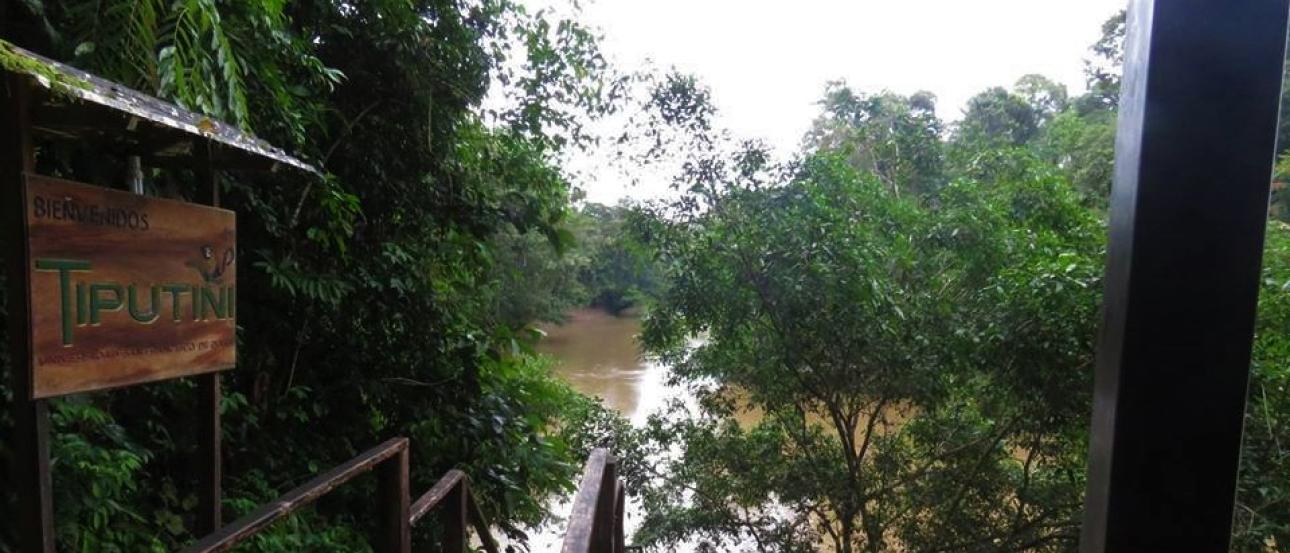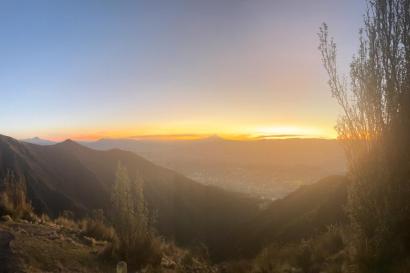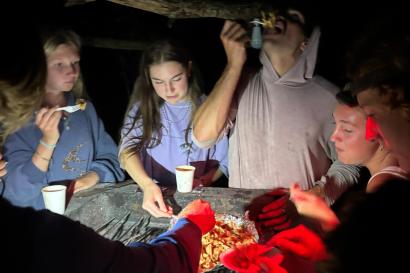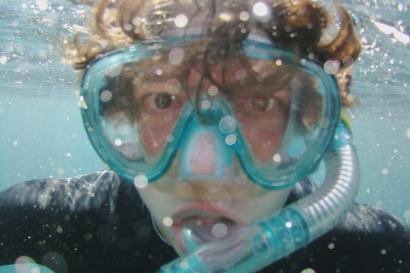On Monday the 20th my host dad drove me to the University at 4 in the morning. From there a charter bus took me and 22 others to the airport where we took a propeller plane to Coca in the lowlands east of the Andes. After hitting the tarmac, we took another bus from the airport, which is about the size of a large house, to Hotel La Mission on the Rio Campo. After our spending an hour coping with our first taste of the humidity at the hotel we loaded our luggage on a riverboat which took us 2 hours downriver past palm and banana plantations to a station owned by an oil company. From there a chiva, an open-air bus/truck hybrid, carried us on a dirt road through the jungle past local Guarani communities until we reached another dock on a smaller river. We arrived just in time to have all our luggage get soaked by our first downpour in the Amazon as we transferred everything from the chiva into another river boat. After another hour-long boat ride through undisturbed jungle we turned a bend in the river and there were two buildings and a dock poking out of the foliage. After 11 hours of travel we arrived dragging our luggage up the stairs into the open-air dining hall of Tiputini Biodiversity Station where a big bowl of Oreos was waiting for us.
Despite the complementary cookies the first thing they made clear to us is that Tiputini is first and foremost a research station – not a resort. The electricity is only active twice a day from 10 to 13 and 18 to 21:30. The cabins are on par with a backwoods summer camp and there’s no hot water in the showers. Still though, for a remote research station their facilities are pretty impressive, and the food is bomb.
Most of the time we didn’t even use the morning electricity because the better part of our days were spent hiking the trails and conducting research in the jungle. The lowland rainforest is absolutely teeming with life. The biggest surprise for me was how loud it is. I imagined that this secluded station in the middle of the uninhabited jungle would be serenely peaceful, but nothing ever shuts up there. The cicadas are going twenty-four seven, there’s grasshoppers that sounds like Buzzsaw’s, the howler monkeys scream before every rain shower, and there’s a chorus of bizarre bird calls for every hour of the day. Apparently, it used to be even louder before all the stream frogs went extinct, unfortunately even pristine sites like Tiputini arn’t safe from chytrid fungus pandemic.

I saw more types of ants and spiders in three days than I ever had before in my life. After a few days of this it really sinks in how deep and complex life in the rainforest is. Our busiest cities are nothing compared to the cosmopolitanism of a few hectares of jungle. On a hike it’s pretty common to see columns of army ants crossing the trails as they carry out their missions. About three days into our stay, a swarm passed through the main camp without any regard for us except to use of our trails. Speaking of ants, I was lucky to meet a well-known researcher whose work with ants in Africa made headlines worldwide this past year. He arrived three days before our departure and was kind enough to present his work to us and give us a glimpse at some unpublished material.
The ants aren’t the only colonial critters though, huge termite nests built of mud are perched on trees all over the forest, and I became well acquainted with the social spiders that live in giant communal webs. The following is an excerpt from my field journal.
I’ve spent most of the last two days catching spiders. We’re conducting an experiment studying if social spiders from the same species but different colonies will cooperate. We’ve focused our experiments on the abundant red spiders that can be found in the hundreds in webs all around camp.
The webs usually stretch several feet from a densely woven bowl at the base to network of threads suspended from a branch or plant.The whole structure acts as a funnel for prey. Insects fly into the upper lattice become entangled and fall to the bottom where the majority of the spiders congregate.
When the spiders sense the vibrations of a captured prey they all pulse towards it in unison. Once upon their victim they swarm it until it just looks like a ball of spiders. From there they either immobilize it and wrap it in a coffin of sticky thread or devour their meal on the spot. I counted 16 spiders feasting on a single beetle at one point.
There were plenty of animals in addition to the bugs. The second day I saw my first wild monkeys in the trees near the canopy observation tower. They were a pair of woolies with a baby eating fruit in the trees above us. Later that day we came within 10 feet of the world’s smallest monkey when we hiked to the tree where a group of pygmy marmosets live. Over the course of the week I saw peccaries, deer, a sloth, and countless birds including flocks of parrots and scarlet macaws. Most of these sighting are thanks to our guide, Roméro, who has a sixth sense in the jungle. I saw this man spot a brown frog under a brown leaf from 10 feet away. On the last day as we were leaving, one of the boats' engines broke down. We turned back to replace it, and as the guides installed the new engine we caught a glimpse of pink river dolphins poking their heads out of the muddy Rio Tiputini.
More than anything though, I'll remember seeing fireflies for the first time in my life as they danced in the dusk around the marmoset tree.


Xavaar Quaranto
<p>I grew up in Eatonville, a small town in Washington just outside the entrance to Mount Ranier National Park, but I moved to Seattle two years ago for college. There's a lot more to do in the city than back home; I've taken dance lessons, played clarinet in a campus band, and this summer I learned how to sail. Exposure to nature here is limited though. I used to go hike in the national park after work, but now I feel like I hardly leave the library! In the Galápagos I plan to spend plenty of time outside both on land and sea.</p>








